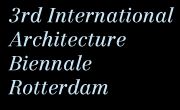| PowerNotes #06 Vedran Mimica on the Biennale | |
The curator of the third IABR is the Berlage Institute. Director of Studies Vedran Mimica, assistant professor Joachim Declerck and guest curator Rients Dijkstra, more specifically, play an important part. | |
|
Rotterdam - Thursday 31 May
The previous two biennales had one person serve as curator. This time the curator is the Berlage Institute. What is your role in this, and what are the advantages and disadvantages of having an institute serve as curator? We always work as a team within the Berlage Institute, so that's nothing new. However, for the IABR project bureau, it can be perhaps easier to work with just one person who's available full-time. We work very closely together, and there is a constant overlap between the curator team and the biennale team. I work as a sort of head curator, whereas Joachim Declerk was the curator for Visionary Power and was involved in almost every aspect of the production regarding the curatorial involvement; finnaly Rients Dijkstra was guest curator for The New Dutch City. All this is done with great commitment. We set out to work together with the Netherlands Architecture Institute, the Boijmans Van Beuningen Museum and the AIR Foundation. With the city we organized a Master Class in Rotterdam Zuid, and we worked with Delft University of Technology on the Indesem master class. The goal is to present Rotterdam as a city of architecture.
In the Visionary Power exhibition, five forces are presented as defining the formation of cities. Why five? Presenting something as complex and abstract as this to both a general and a professional audience requires categorization. This naturally implies the risk of leaving something out. Of course it is not only these five forces that define the city. Reality is far more complex. But we selected these five in order to keep it presentable. Our selection is being confirmed in the media: every day, BBC World, CNN and the NOS report on items connected to these forces.
| Isn't the climate a significant force? Yes, it is certainly a significant force. But for this biennale, we didn't see the direct impact of the climate (or natural disasters) on the production of the city yet. How an architect can use the climate to build a city needs to go beyond building an ecologically responsible house. Some teams, like the team from Busan, do address the subject. The climate might be a good issue for the next biennale. There are, of course, interesting developments, such as Arup's Dongtan Eco-City in Shanghai. At the moment, however, there are too few really good examples.
Do you see the five forces as equal? In principle, the forces are all quite different. In each case the relationship among the forces is different and it has different effects on the production of the city. To us, it's important to create an interesting connection between these forces that influence the city and the production of architecture. That was the goal. That is at least as interesting as what we've been focusing on in the last two decades, such as researching a new materials or a new philosophy.
How would you briefly summarize the message of the biennale? The architecture community must develop new strategies and tools to connect with reality. We should not cut ourselves off, but create our own vision of reality. As an architect you need to always be alert. Developments take place very quickly. |
POWER -
Producing the Contemporary City
24 May - 2 September 2007
Producing the Contemporary City
24 May - 2 September 2007
Nederlands | English
"The city of the 21st century can be seen here in Carácas."
(Alfredo Brillembourg and Hubert Klumpner in Carácas. The Informal City, 2007)

